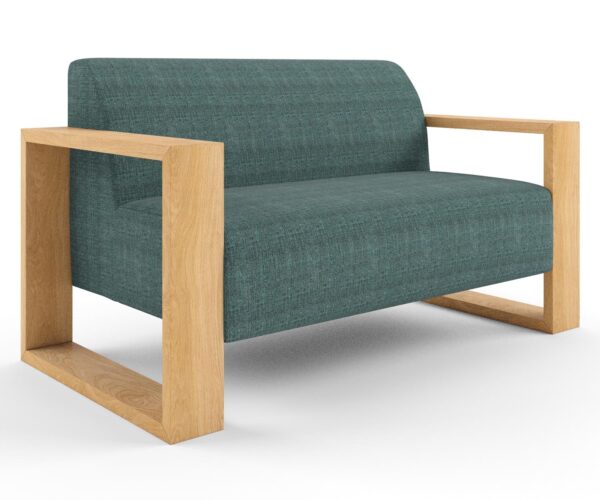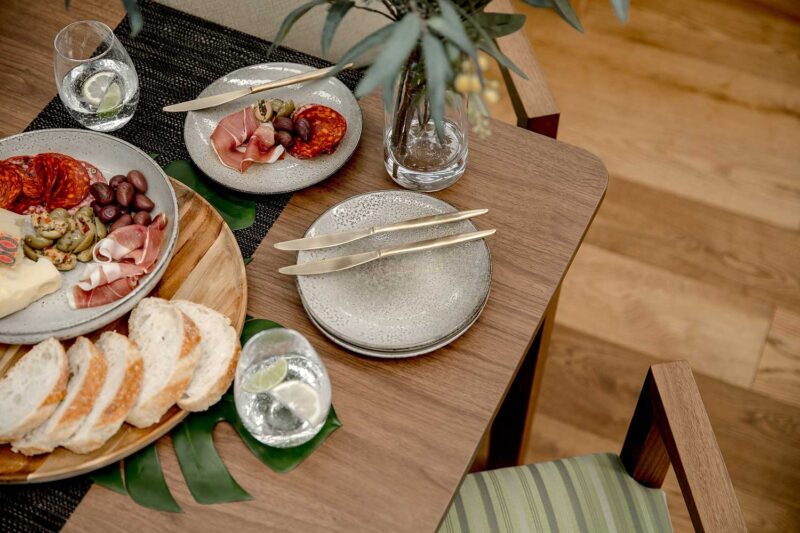Rethinking Service Environments for Dementia: Tips for Implementing the [Updated] National Aged Care Design Principles

As we mark Dementia Action Week (16-22 September), it’s crucial to consider how our design choices in Australian aged care service environments can significantly impact the lives of individuals living with dementia. With nearly two-thirds (63%) of the estimated 411,100 Australians living with dementia being women, and projections indicating that the number will more than double by 2058, creating supportive environments is more important than ever. (Source: Australian Institute of Health and Welfare.)
The Importance of Thoughtful Design
Dementia remains a major concern in Australia, with 54% of the 242,000 people in permanent residential aged care having dementia as of 2021-22. In 2022, dementia was the second leading cause of death in Australia and the leading cause of death for women. This underscores the urgent need for environments that cater to the specific needs of those living with dementia. (Source: Australian Institute of Health and Welfare.)
Implementing the Updated National Aged Care Design Principles and Guidelines
The Australian Government’s National Aged Care Design Principles and Guidelines have recently been updated, with the new version released on 21 August 2024. These guidelines offer a comprehensive framework for creating environments that enhance the safety, comfort, and quality of life for aged care residents.
About the Design Principles
The four Principles aim to improve design for everyone living and working in residential aged care. They integrate lessons learned from the COVID-19 pandemic and encourage stronger alignment between care models and design. Each Principle addresses a specific design challenge in aged care and focuses on promoting residents’ rights, valuing care staff, and fostering positive relationships between residents, families, and staff.
Tips for Implementing these Updated Principles for Accessible and Dementia-friendly Design in Aged Care
1. Principle 1: Enable the Person
This principle supports individuals in maintaining their health, wellbeing, and sense of identity. Use the following checklist to align with the updated National Aged Care Design Principles:
- Minimise Visual Clutter: Remove or discreetly store non-essential items to reduce confusion.
- Noise Reduction: Implement noise elimination strategies to create a soothing environment.
- Contrasting Tones: Use contrasting colours to clarify key surfaces and reduce visual confusion.
- Simplify Circulation: Ensure pathways are straightforward and easy to navigate without excessive signage.
- Comfortable Seating: Provide supportive seating in common areas.
- Accessible Toilets: Ensure toilets are easy to locate and use, with ample space for manoeuvring.
- Air Quality: Maintain good air quality and comfortable temperatures throughout the year.
- Nature Indoors: Integrate natural elements to create a calming atmosphere.
2. Principle 2: Cultivate a Home
Creating a familiar and homely environment is crucial for improving residents’ quality of life. Follow this checklist to implement Principle 2 of the updated guidelines:
- Personal Touches: Furnish bedrooms and living areas with personal items and ensure each resident has a private bedroom and bathroom.
- Small Household Models: Opt for environments with no more than 15 residents to foster a homely feel.
- Private Entries: Design entries to minimise disruption and maintain privacy.
- Domestic-Style Kitchen: Include a kitchen adjacent to the dining area, accessible to residents and visitors.
- Activity Areas: Create spaces for small group activities that reflect residents’ cultures and preferences.
- Short Corridors: Keep corridors short and use landmarks and seating to aid navigation.
- Domestic Furniture: Choose furniture that looks and feels like home while being fit for purpose.
- Handwashing Stations: Provide accessible handwashing and clinical support stations, discreetly located.
- Staff Break Areas: Design comfortable staff break areas away from resident spaces.
3. Principle 3: Access to Outdoors
Access to outdoor spaces is vital for residents’ health and wellbeing. Implement this checklist to enhance outdoor environments in line with the updated guidelines:
- Safe Gardens/Balconies: Provide gardens or balconies that are safe, accessible, and an extension of living spaces.
- Visibility and Access: Ensure good visibility and direct access to outdoor areas from living spaces.
- Variety of Spaces: Create diverse outdoor areas for different activities, ensuring they are sheltered and large enough for small group gatherings.
- Clear Paths: Design clear, simple garden paths with seating and adequate width for various mobility levels.
4. Principle 4: Connect with Community
Encouraging social connections is crucial for residents’ emotional wellbeing. Use this checklist to support community engagement according to the updated guidelines:
- Proximity to Amenities: Locate aged care homes near community amenities such as shops and cafes.
- Public Amenities: Develop visible public amenities inside or adjacent to the home, such as social clubs and places of worship.
- Easy Routes: Design easy-to-follow routes between popular areas within the home, using familiar landmarks and signage.
- Neighbourhood Integration: Ensure the building design integrates seamlessly with the local neighbourhood.
As we observe Dementia Action Week, let’s embrace the updated National Aged Care Design Principles and Guidelines to create environments that genuinely enhance the lives of people living with dementia. By focusing on enabling individuals, cultivating a homely atmosphere, ensuring access to outdoor spaces, and fostering community connections, we can design spaces that support and enrich residents’ lives. Implementing these principles not only addresses physical needs but also promotes emotional and social wellbeing, making a meaningful difference in their daily experiences.
Australian Made Aged Care Furniture: Fit-For-Purpose Furniture Designed to Improve Quality of Life for Older People
More News
Rethinking Service Environments for Dementia: Tips for Implementing the [Updated] National Aged Care Design Principles

As we mark Dementia Action Week (16-22 September), it’s crucial to consider how our design choices in Australian aged care service environments can significantly impact the lives of individuals living with dementia. With nearly two-thirds (63%) of the estimated 411,100 Australians living with dementia being women, and projections indicating that the number will more than double by 2058, creating supportive environments is more important than ever. (Source: Australian Institute of Health and Welfare.)
The Importance of Thoughtful Design
Dementia remains a major concern in Australia, with 54% of the 242,000 people in permanent residential aged care having dementia as of 2021-22. In 2022, dementia was the second leading cause of death in Australia and the leading cause of death for women. This underscores the urgent need for environments that cater to the specific needs of those living with dementia. (Source: Australian Institute of Health and Welfare.)
Implementing the Updated National Aged Care Design Principles and Guidelines
The Australian Government’s National Aged Care Design Principles and Guidelines have recently been updated, with the new version released on 21 August 2024. These guidelines offer a comprehensive framework for creating environments that enhance the safety, comfort, and quality of life for aged care residents.
About the Design Principles
The four Principles aim to improve design for everyone living and working in residential aged care. They integrate lessons learned from the COVID-19 pandemic and encourage stronger alignment between care models and design. Each Principle addresses a specific design challenge in aged care and focuses on promoting residents’ rights, valuing care staff, and fostering positive relationships between residents, families, and staff.
Tips for Implementing these Updated Principles for Accessible and Dementia-friendly Design in Aged Care
1. Principle 1: Enable the Person
This principle supports individuals in maintaining their health, wellbeing, and sense of identity. Use the following checklist to align with the updated National Aged Care Design Principles:
- Minimise Visual Clutter: Remove or discreetly store non-essential items to reduce confusion.
- Noise Reduction: Implement noise elimination strategies to create a soothing environment.
- Contrasting Tones: Use contrasting colours to clarify key surfaces and reduce visual confusion.
- Simplify Circulation: Ensure pathways are straightforward and easy to navigate without excessive signage.
- Comfortable Seating: Provide supportive seating in common areas.
- Accessible Toilets: Ensure toilets are easy to locate and use, with ample space for manoeuvring.
- Air Quality: Maintain good air quality and comfortable temperatures throughout the year.
- Nature Indoors: Integrate natural elements to create a calming atmosphere.
2. Principle 2: Cultivate a Home
Creating a familiar and homely environment is crucial for improving residents’ quality of life. Follow this checklist to implement Principle 2 of the updated guidelines:
- Personal Touches: Furnish bedrooms and living areas with personal items and ensure each resident has a private bedroom and bathroom.
- Small Household Models: Opt for environments with no more than 15 residents to foster a homely feel.
- Private Entries: Design entries to minimise disruption and maintain privacy.
- Domestic-Style Kitchen: Include a kitchen adjacent to the dining area, accessible to residents and visitors.
- Activity Areas: Create spaces for small group activities that reflect residents’ cultures and preferences.
- Short Corridors: Keep corridors short and use landmarks and seating to aid navigation.
- Domestic Furniture: Choose furniture that looks and feels like home while being fit for purpose.
- Handwashing Stations: Provide accessible handwashing and clinical support stations, discreetly located.
- Staff Break Areas: Design comfortable staff break areas away from resident spaces.
3. Principle 3: Access to Outdoors
Access to outdoor spaces is vital for residents’ health and wellbeing. Implement this checklist to enhance outdoor environments in line with the updated guidelines:
- Safe Gardens/Balconies: Provide gardens or balconies that are safe, accessible, and an extension of living spaces.
- Visibility and Access: Ensure good visibility and direct access to outdoor areas from living spaces.
- Variety of Spaces: Create diverse outdoor areas for different activities, ensuring they are sheltered and large enough for small group gatherings.
- Clear Paths: Design clear, simple garden paths with seating and adequate width for various mobility levels.
4. Principle 4: Connect with Community
Encouraging social connections is crucial for residents’ emotional wellbeing. Use this checklist to support community engagement according to the updated guidelines:
- Proximity to Amenities: Locate aged care homes near community amenities such as shops and cafes.
- Public Amenities: Develop visible public amenities inside or adjacent to the home, such as social clubs and places of worship.
- Easy Routes: Design easy-to-follow routes between popular areas within the home, using familiar landmarks and signage.
- Neighbourhood Integration: Ensure the building design integrates seamlessly with the local neighbourhood.
As we observe Dementia Action Week, let’s embrace the updated National Aged Care Design Principles and Guidelines to create environments that genuinely enhance the lives of people living with dementia. By focusing on enabling individuals, cultivating a homely atmosphere, ensuring access to outdoor spaces, and fostering community connections, we can design spaces that support and enrich residents’ lives. Implementing these principles not only addresses physical needs but also promotes emotional and social wellbeing, making a meaningful difference in their daily experiences.
Australian Made Aged Care Furniture: Fit-For-Purpose Furniture Designed to Improve Quality of Life for Older People
Discover the FHG Look Book: Your Source of Inspiration for Quality Australian-Made Commercial Furniture
- Quality Craftsmanship: See why we’ve been a trusted partner for over 25 years.
- Local Excellence: Learn how our Brisbane team ensures the highest standards.
- Inspiration and Ideas: Find innovative furniture solutions for any environment.
Don’t miss the opportunity to transform your commercial space with FHG’s expertly crafted furniture. Download the FHG Look Book today and start your journey towards exceptional design and quality.
































